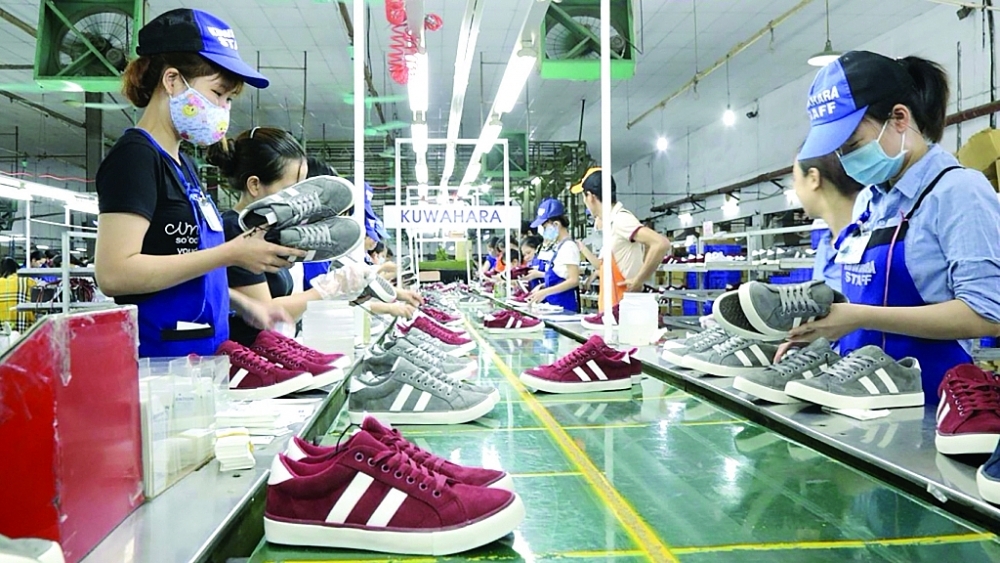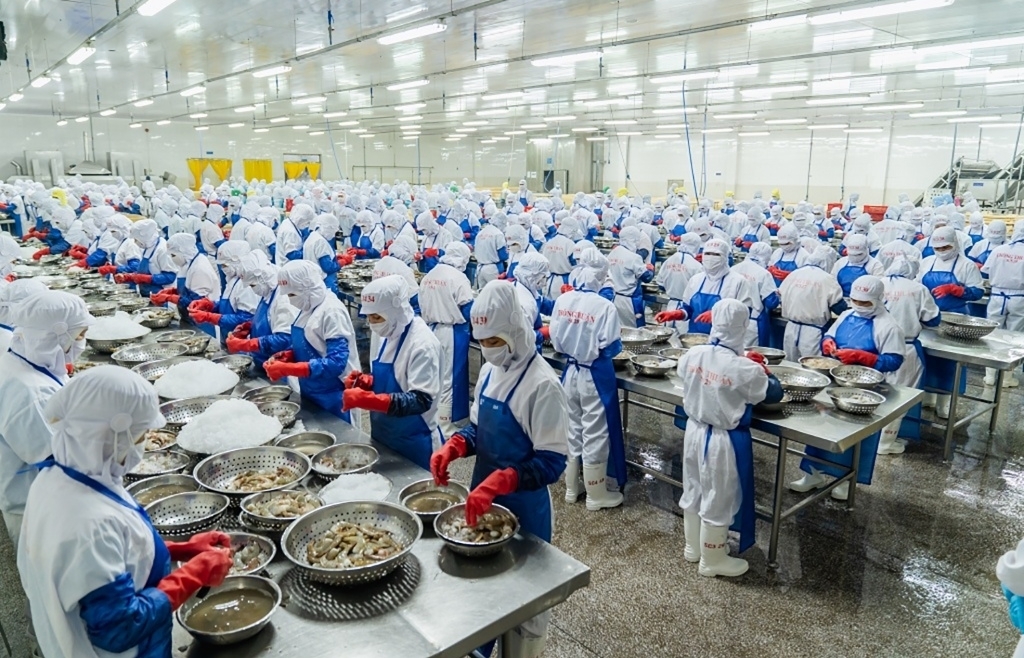Making good use of opportunities from EVFTA, leather and footwear exports accelerate to the EU
| Textile and garment exports are not as expected despite EVFTA | |
| Instruction on certificate of origin in CPTPP and EVFTA | |
| Understand regulations to successfully export via e-commerce |
 |
| Vietnam is in the group of markets supplying footwear to the EU with a turnover of over US$1 billion /year, ranking second among foreign markets supplying all kinds of footwear to the EU. Photo: Internet |
Nearly 99% of exported goods can take advantage of incentives
After eight months of implementing the EVFTA (from August 1, 2020), footwear is on the list of Vietnam's export products with positive changes.
According to statistics of the General Department of Customs, from August 2020 to March 2021, there have been six months of Vietnam's footwear exports to the EU increasing (except for February 2021, footwear exports to the EU of all kinds to the EU decreased due to the Lunar New Year holiday).
Compared with before the Covid-19 pandemic, Vietnam's footwear exports to the EU market had remarkable growth in the first quarter of this year. Specifically, in the first quarter of 2021, footwear exports to the EU increased by 19.2% over the same period in 2020 (in the first quarter of 2020 it increased by only 0.1% and in the first quarter of 2019 increased by 11.9%).
In order to enjoy tariff preferences from the EVFTA, Vietnamese leather and footwear products must meet the provisions of the rules of origin of goods under this agreement, and be granted a Certificate of Origin (C/O) sample EUR.1.
According to Mr. Tran Thanh Hai, Deputy Director of the Import-Export Department (Ministry of Industry and Trade), from August 1, 2020 to December 31, 2020, the turnover of Vietnam's leather and footwear products (including footwear and other related items such as handbags, wallets, suitcases) exported to the EU, which are granted a C/O form EUR.1 by agencies and organizations under the EVFTA, is US$1.37 billion. This figure has reached US$1.17 billion in the first quarter of 2021.
In the EVFTA, which was developed by the Import-Export Department in collaboration with the Industry and Trade Information Center (Ministry of Industry and Trade), and issued on June 1, 2021, these two units assessed: “It is possible that footwear is one of the products that make good use of tariff preferences in the EVFTA by meeting the provisions of the corresponding rules of origin of goods in the agreement. In terms of numbers, in the first quarter of 2021, the proportion of footwear products exported to the EU market using C/O form EUR.1 under the EVFTA is up to 98.98%.”
Warning about supply chains
The representative of the Import-Export Department said, compared with textiles, which are also one of Vietnam's key export products in the EU market, the criteria of origin for goods of footwear products in the EVFTA are relatively flexible.
Besides, some economic experts said that the EU's fast and deep tariff reduction roadmap for Vietnam in the EVFTA is also an important driving force to increase the export of leather and footwear products to this market.
Under the EVFTA, 100% of footwear lines will be reduced to 0% with a maximum roadmap of seven years. In which, footwear products of HS 64.01, 64.02, 64.03, 64.05, 64.06 are basically reduced to 0% as soon as the agreement comes into effect (except for a few lines of reduction in three or five years in HS 64.04 and 64.05); HS 64.03 products have a longer reduction schedule from three to seven years.
This helps leather and footwear exporters to enjoy a tax rate of 0%, which is more beneficial than the Generalized Preferential Tariff Mechanism (GSP) since the time the EVFTA comes into effect.
The Import-Export Department and the Industry and Trade Information Center have stated that the origin criteria for leather and footwear products in the EVFTA are relatively flexible and allow the import of materials outside the bloc to produce goods. However, the interruption of the global supply chain due to the impact of the Covid-19 pandemic is an alarm bell for the domestic footwear industry when it depends heavily on imported raw materials. To be able to develop sustainably and make the most of tariff preferences as well as opportunities brought by the EVFTA, leather and footwear enterprises need to focus on developing a balance of domestically produced raw materials to serve their needs production and export in the future.
From the perspective of businesses and industries, Ms. Phan Thi Thanh Xuan, General Secretary of the Vietnam Leather, Footwear and Handbag Association said that raw materials for the leather and footwear industry in Vietnam are mainly imported from China (60%), followed by Korea and Taiwan (China).
In recent years, the initiative of raw materials has changed when enterprises have gradually moved the supply chain of producing raw materials to Vietnam.
However, that problem only applies to large enterprises. Small and medium enterprises have limited resources, so they have not been proactive in dealing with local raw materials.
“We hope that the raw material development strategy needs to create a specialized industrial zone for the leather, footwear and textile industries to be developed and have better preferential tariff regimes to promote develop materials and accessories produced in Vietnam,” said Ms. Xuan.
Related News
Latest News

VN's food processing industry struggles to improve quality and value chain integration
15:53 | 22/11/2024 Import-Export

Approach strategy of the seafood industry when implementing UKVFTA
09:26 | 22/11/2024 Import-Export

Mid-November: Vietnam's trade volume matches 2023 total, eyes record-breaking growth
09:25 | 22/11/2024 Import-Export

Vietnamese enterprises facing challenges from cross-border e-commerce platforms
14:32 | 21/11/2024 Import-Export
More News

Vietnam, Malaysia eye new milestone in trade ties
14:29 | 21/11/2024 Import-Export
Shrimp exports surge in 10 months, generating 3.2 billion USD
14:27 | 21/11/2024 Import-Export

Vietnam’s exports to the U.S. near US$100 billion milestone
09:46 | 21/11/2024 Import-Export

From the “abnormal” coffee price, worries about the new crop
09:46 | 21/11/2024 Import-Export

What obstacles limit the market share of Vietnamese goods in the UK?
14:49 | 20/11/2024 Import-Export

Why seafood exports to some Middle Eastern Countries are stalled
14:47 | 20/11/2024 Import-Export

Storm No. 3 destroys profits of many insurance companies
14:45 | 20/11/2024 Import-Export

Vietnam, Malaysia eye golden partnership opportunities in Halal industry
14:44 | 20/11/2024 Import-Export

Tra fish sector aiming for production, processing greening for sustainable development
14:41 | 20/11/2024 Import-Export
Your care

VN's food processing industry struggles to improve quality and value chain integration
15:53 | 22/11/2024 Import-Export

Approach strategy of the seafood industry when implementing UKVFTA
09:26 | 22/11/2024 Import-Export

Mid-November: Vietnam's trade volume matches 2023 total, eyes record-breaking growth
09:25 | 22/11/2024 Import-Export

Vietnamese enterprises facing challenges from cross-border e-commerce platforms
14:32 | 21/11/2024 Import-Export

Vietnam, Malaysia eye new milestone in trade ties
14:29 | 21/11/2024 Import-Export





